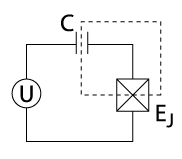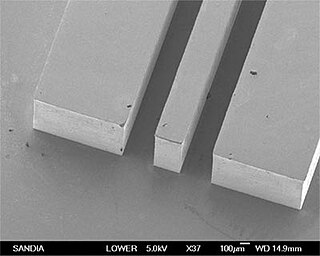
This is a timeline of quantum computing.
In logic circuits, the Toffoli gate, also known as the CCNOT gate (“controlled-controlled-not”), invented by Tommaso Toffoli, is a CNOT gate with two control qubits and one target qubit. That is, the target qubit will be inverted if the first and second qubits are both 1. It is a universal reversible logic gate, which means that any classical reversible circuit can be constructed from Toffoli gates.
A Bell test, also known as Bell inequality test or Bell experiment, is a real-world physics experiment designed to test the theory of quantum mechanics in relation to Albert Einstein's concept of local realism. Named for John Stewart Bell, the experiments test whether or not the real world satisfies local realism, which requires the presence of some additional local variables to explain the behavior of particles like photons and electrons. The test empirically evaluates the implications of Bell's theorem. As of 2015, all Bell tests have found that the hypothesis of local hidden variables is inconsistent with the way that physical systems behave.
Quantum error correction (QEC) is a set of techniques used in quantum computing to protect quantum information from errors due to decoherence and other quantum noise. Quantum error correction is theorised as essential to achieve fault tolerant quantum computing that can reduce the effects of noise on stored quantum information, faulty quantum gates, faulty quantum state preparation, and faulty measurements. Effective quantum error correction would allow quantum computers with low qubit fidelity to execute algorithms of higher complexity or greater circuit depth.

In quantum computing, a charge qubit is a qubit whose basis states are charge states. In superconducting quantum computing, a charge qubit is formed by a tiny superconducting island coupled by a Josephson junction to a superconducting reservoir. The state of the qubit is determined by the number of Cooper pairs that have tunneled across the junction. In contrast with the charge state of an atomic or molecular ion, the charge states of such an "island" involve a macroscopic number of conduction electrons of the island. The quantum superposition of charge states can be achieved by tuning the gate voltage U that controls the chemical potential of the island. The charge qubit is typically read-out by electrostatically coupling the island to an extremely sensitive electrometer such as the radio-frequency single-electron transistor.
Superconducting quantum computing is a branch of solid state physics and quantum computing that implements superconducting electronic circuits using superconducting qubits as artificial atoms, or quantum dots. For superconducting qubits, the two logic states are the ground state and the excited state, denoted respectively. Research in superconducting quantum computing is conducted by companies such as Google, IBM, IMEC, BBN Technologies, Rigetti, and Intel. Many recently developed QPUs use superconducting architecture.
A quantum bus is a device which can be used to store or transfer information between independent qubits in a quantum computer, or combine two qubits into a superposition. It is the quantum analog of a classical bus.
Circuit quantum electrodynamics provides a means of studying the fundamental interaction between light and matter. As in the field of cavity quantum electrodynamics, a single photon within a single mode cavity coherently couples to a quantum object (atom). In contrast to cavity QED, the photon is stored in a one-dimensional on-chip resonator and the quantum object is no natural atom but an artificial one. These artificial atoms usually are mesoscopic devices which exhibit an atom-like energy spectrum. The field of circuit QED is a prominent example for quantum information processing and a promising candidate for future quantum computation.

In quantum computing, and more specifically in superconducting quantum computing, a transmon is a type of superconducting charge qubit designed to have reduced sensitivity to charge noise. The transmon was developed by Robert J. Schoelkopf, Michel Devoret, Steven M. Girvin, and their colleagues at Yale University in 2007. Its name is an abbreviation of the term transmission line shunted plasma oscillation qubit; one which consists of a Cooper-pair box "where the two superconductors are also [capacitively] shunted in order to decrease the sensitivity to charge noise, while maintaining a sufficient anharmonicity for selective qubit control".
In quantum mechanics, the cat state, named after Schrödinger's cat, refers to a quantum state composed of a superposition of two other states of flagrantly contradictory aspects. Generalizing Schrödinger's thought experiment, any other quantum superposition of two macroscopically distinct states is also referred to as a cat state. A cat state could be of one or more modes or particles, therefore it is not necessarily an entangled state. Such cat states have been experimentally realized in various ways and at various scales.

Coplanar waveguide is a type of electrical planar transmission line which can be fabricated using printed circuit board technology, and is used to convey microwave-frequency signals. On a smaller scale, coplanar waveguide transmission lines are also built into monolithic microwave integrated circuits.

Robert J. Schoelkopf III is an American physicist, most noted for his work on quantum computing as one of the inventors of superconducting qubits. Schoelkopf's main research areas are quantum transport, single-electron devices, and charge dynamics in nanostructures. His research utilizes quantum-effect and single-electron devices, both for fundamental physical studies and for applications. Techniques often include high-speed, high-sensitivity measurements performed on nanostructures at low temperatures. Schoelkopf serves as director of the Yale Center for Microelectronic Materials and Structures and as associate director of the Yale Institute for Nanoscience and Quantum Engineering. Since 2014, Schoelkopf is also the Director of the Yale Quantum Institute. He is Professor of Physics and Sterling Professor of Applied Physics at Yale University. The title of Sterling Professor is the highest honor bestowed upon Yale faculty.

Michel Devoret is a French physicist and F. W. Beinecke Professor of Applied Physics at Yale University. He also holds a position as the Director of the Applied Physics Nanofabrication Lab at Yale. He is known for his pioneering work on macroscopic quantum tunneling, and the single-electron pump as well as in groundbreaking contributions to initiating the fields of circuit quantum electrodynamics and quantronics.

Yasunobu Nakamura (中村 泰信 Nakamura Yasunobu) is a Japanese physicist. He is a professor at the University of Tokyo's Research Center for Advanced Science and Technology (RCAST) and the Principal Investigator of the Superconducting Quantum Electronics Research Group (SQERG) at the Center for Emergent Matter Science (CEMS) within RIKEN. He has contributed primarily to the area of quantum information science, particularly in superconducting quantum computing and hybrid quantum systems.

Irfan Siddiqi is an American physicist and currently a professor of physics at the University of California, Berkeley and a faculty scientist at Lawrence Berkeley National Laboratory (LBNL).
In quantum computing, quantum supremacy or quantum advantage is the goal of demonstrating that a programmable quantum computer can solve a problem that no classical computer can solve in any feasible amount of time, irrespective of the usefulness of the problem. The term was coined by John Preskill in 2012, but the concept dates to Yuri Manin's 1980 and Richard Feynman's 1981 proposals of quantum computing.

Jerry M. Chow is a physicist who conducts research in quantum information processing. He has worked as the manager of the Experimental Quantum Computing group at the IBM Thomas J. Watson Research Center in Yorktown Heights, New York since 2014 and is the primary investigator of the IBM team for the IARPA Multi-Qubit Coherent Operations and Logical Qubits programs. After graduating magna cum laude with a B.A. in physics and M.S. in applied mathematics from Harvard University, he went on to earn his Ph.D. in 2010 under Robert J. Schoelkopf at Yale University. While at Yale, he participated in experiments in which superconducting qubits were coupled via a cavity bus for the first time and two-qubit algorithms were executed on a superconducting quantum processor.

An electron-on-helium qubit is a quantum bit for which the orthonormal basis states |0⟩ and |1⟩ are defined by quantized motional states or alternatively the spin states of an electron trapped above the surface of liquid helium. The electron-on-helium qubit was proposed as the basic element for building quantum computers with electrons on helium by Platzman and Dykman in 1999.
Andrew A. Houck is an American physicist, quantum information scientist, and professor of electrical and computer engineering at Princeton University. He is director of the Co-Design Center for Quantum Advantage, a national research center funded by the U.S. Department of Energy Office of Science, as well as co-director of the Princeton Quantum Initiative. His research focuses on superconducting electronic circuits to process and store information for quantum computing and to simulate and study many-body physics. He is a pioneer of superconducting qubits.

!["A gate-defined GaAs double quantum dot (DQD) and a frequency-tunable high impedance resonator realized using an array of superconducting quantum interference devices... [This] false-color optical micrograph of a representative device [indicates] the substrate (dark gray), the superconducting structures (light gray), the gold top gates (yellow) forming the DQD, and its source and drain leads and contacts (blue)." Double Quantum Dot, 10.1103.PhysRevX.7.011030 (A. Wallraff, 2017).png](http://upload.wikimedia.org/wikipedia/commons/thumb/1/1d/Double_Quantum_Dot%2C_10.1103.PhysRevX.7.011030_%28A._Wallraff%2C_2017%29.png/220px-Double_Quantum_Dot%2C_10.1103.PhysRevX.7.011030_%28A._Wallraff%2C_2017%29.png)









